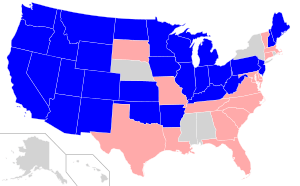Child Labor Amendment facts for kids
The Child Labor Amendment is a proposed change to the U.S. Constitution. It would give the U.S. Congress the power to make rules about "labor of persons under eighteen years of age." This means Congress could limit or stop children and teenagers from working in certain jobs.
This amendment was suggested in 1924. This happened after the Supreme Court made decisions in 1918 and 1922. The Court said that earlier federal laws trying to control child labor were not allowed by the Constitution.
Many states approved the amendment by the mid-1930s. However, it still hasn't been approved by enough states to become law. The Constitution says three-fourths of the states must agree. No states have approved it since 1937. People lost interest in the amendment after the Fair Labor Standards Act of 1938 was passed. This law put federal rules on child labor, and the Supreme Court approved it in 1941.
Because Congress didn't set a time limit for states to approve it, the amendment is still technically waiting. If ten more states approve it, it could still become a part of the Constitution.
Contents
What the Amendment Says
The proposed amendment has two main parts:
Section 1
Congress would have the power to limit, regulate, and stop people under 18 from working.Section 2
The power of the states to make their own laws about child labor would still exist. However, if a state law conflicts with a federal law made by Congress under this amendment, the federal law would be followed.
Why Was It Proposed?
Before this amendment, Congress tried to control child labor in other ways. In 1916, they passed the Keating–Owen Act. This law tried to stop goods made by child workers (under 14 or 16, depending on the job) from being sold between states. But the Supreme Court said this law was unconstitutional in a case called Hammer v. Dagenhart (1918).
Later, Congress tried to tax businesses that used child labor. The Supreme Court also struck down this tax in the Bailey v. Drexel Furniture case. It became clear that a new constitutional amendment was needed to give Congress the power to make these kinds of laws.
How It Was Proposed in Congress
The idea for the Child Labor Amendment came from Israel Moore Foster, a Congressman from Ohio. He introduced it on April 26, 1924.
The United States House of Representatives approved the amendment on April 26, 1924. The Senate approved it on June 2, 1924. After that, the proposed amendment was sent to the state legislatures for them to vote on.
Which States Approved It (or Didn't)
Once Congress approved the amendment, it was sent to the states. Here are the states that approved it:
- Arkansas — June 28, 1924
- California — January 8, 1925
- Arizona — January 29, 1925
- Wisconsin — February 25, 1925
- Montana — February 11, 1927
- Colorado — April 28, 1931
- Oregon — January 31, 1933
- Washington — February 3, 1933
- North Dakota — March 4, 1933
- Ohio — March 22, 1933
- Michigan — May 10, 1933
- New Hampshire — May 17, 1933
- New Jersey — June 12, 1933
- Illinois — June 30, 1933
- Oklahoma — July 5, 1933
- Iowa — December 5, 1933
- West Virginia — December 12, 1933
- Minnesota — December 14, 1933
- Maine — December 16, 1933
- Pennsylvania — December 21, 1933
- Wyoming — January 31, 1935
- Utah — February 5, 1935
- Idaho — February 7, 1935
- Indiana — February 8, 1935
- Kentucky — January 13, 1937
- Nevada — January 29, 1937
- New Mexico — February 12, 1937
- Kansas — February 25, 1937
Fifteen states rejected the amendment. These included Connecticut, Delaware, Florida, Georgia, Louisiana, Maryland, Massachusetts, Missouri, North Carolina, South Carolina, South Dakota, Tennessee, Texas, Vermont, and Virginia. Even though rejecting an amendment doesn't stop it from being considered later, it showed their opinion at the time.
Out of the 48 states in 1924, five states never voted on the amendment. These were Alabama, Mississippi, Nebraska, New York, and Rhode Island. Also, Alaska and Hawaii, which became states later, have not voted on it. Today, there are 50 states, so 38 states need to approve an amendment for it to pass. This means 10 more states would need to approve the Child Labor Amendment for it to become law.
What Happened Next?
If the Child Labor Amendment were approved, Congress would share power with the states to make laws about child labor. Federal laws would be followed if they conflicted with state laws.
Many states that first said no to the amendment changed their minds in the 1930s and approved it. These delayed approvals led to a Supreme Court case in 1939 called Coleman v. Miller. The Court decided that the Child Labor Amendment is still waiting for states to act because Congress didn't set a deadline. This decision was important because it also helped the 27th Amendment become law. That amendment was proposed in 1789 but wasn't approved until 1992!
The way people thought about federal child labor laws changed in the 1930s. In 1938, Congress passed the Fair Labor Standards Act. This law set rules for employing people under 16 or 18. In 1941, the Supreme Court fully supported this new law in the case United States v. Darby Lumber Co.. This decision actually overturned the earlier Hammer v. Dagenhart case, which was one of the reasons the Child Labor Amendment was proposed. Because of this new law and court decision, the Child Labor Amendment became less important and is now considered "moot," meaning it's no longer a pressing issue.
Images for kids



